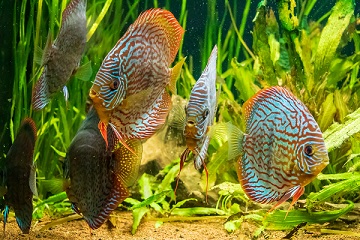Pygmy Sucker Fish, scientifically known as Otocinclus macrospilus, are charming aquatic creatures that have captured the hearts of many aquarium enthusiasts. These diminutive fish, native to South America, are renowned for their endearing appearance and valuable contributions to maintaining a clean and algae-free tank. In this article, we will dive into the world of Pygmy Sucker Fish, exploring their habitat, unique characteristics, and the intricacies of keeping them in your aquarium.
Table of Contents
ToggleHabitat and Distribution
Pygmy Sucker Fish are primarily found in the freshwater rivers and streams of South America, with a significant presence in countries like Brazil, Peru, and Colombia. They inhabit slow-moving waters, densely vegetated areas, and regions with rocky substrates. These habitats provide them with ample opportunities to graze on algae, which is a staple of their diet.
Physical Characteristics
These miniature marvels typically grow to around 1 to 2 inches, making them the perfect addition to small to medium-sized aquariums. They have a sleek, elongated body covered in bony plates. Their coloration can vary, but they often feature a mottled pattern that helps them blend into their surroundings. One of their most distinctive features is the presence of a sucker-shaped mouth, which they use to cling to surfaces, especially when feeding on algae.
Behavior and Feeding Habits
Pygmy Sucker Fish are known for their peaceful and social behavior. They are often observed in groups, and their gentle disposition makes them an excellent choice for community aquariums. Their primary diet consists of algae, which they scrape off rocks, plants, and glass. This natural behavior not only helps to maintain a clean and algae-free tank but also provides these fish with essential nutrients.
Reproduction
Reproduction in Pygmy Sucker Fish can be challenging in a home aquarium. They are egg layers and specific environmental conditions and diet often influence breeding success. It’s essential to create a suitable environment and provide a balanced diet to encourage breeding.
Importance in Aquaria
Pygmy Sucker Fish play a vital role in maintaining a balanced and healthy aquarium ecosystem. Their algae-eating habits keep the tank clean and prevent the overgrowth of unwanted greenery. This not only benefits the fish but also enhances the overall aesthetic appeal of the aquarium.
Caring for Pygmy Sucker Fish
To ensure the well-being of your Pygmy Sucker Fish, it’s crucial to provide them with a suitable environment. Keep the water quality pristine, maintain a well-planted tank, and ensure they have a variety of surfaces to graze on. These conditions mimic their natural habitat and promote their overall health.
Common Varieties
There are various Pygmy Sucker Fish varieties, each with unique characteristics and colorations. Some popular types include the Zebra Otocinclus and the Dwarf Otocinclus, each with a distinct charm.
Tank Setup
When setting up a tank for Pygmy Sucker Fish, choose a tank size that suits the number of fish you intend to keep. A well-planted tank with ample hiding spots and a slow water flow is ideal. These fish are sensitive to water parameters, so regular monitoring and maintenance are necessary.
Compatibility with Other Fish
Pygmy Sucker Fish are generally peaceful and can coexist with many other fish species, especially those with a non-aggressive nature. However, be cautious about housing them with larger, more boisterous fish that may intimidate or harm them.
Challenges in Keeping Pygmy Sucker Fish
While Pygmy Sucker Fish are beautiful additions to an aquarium, they do present some challenges. Breeding can be complex, and maintaining the right water conditions and diet can be demanding.
Tips for Keeping Pygmy Sucker Fish Healthy
Maintaining Pygmy Sucker Fish’s health involves providing them with a clean environment, a balanced diet, and a stress-free atmosphere. Regular water changes and observation are crucial to ensuring their well-being.
Breeding Pygmy Sucker Fish
Breeding Pygmy Sucker Fish can be a rewarding experience for dedicated aquarium enthusiasts. Creating the right conditions for breeding, such as suitable water parameters and nutrition, is essential to increase the chances of successful reproduction.
Conservation Status
In their natural habitats, Pygmy Sucker Fish face threats from habitat destruction and pollution. As responsible aquarists, it’s essential to support sustainable practices and consider the origin of these fish when purchasing them.
Conclusion
In summary, Pygmy Sucker Fish are not only delightful to look at but also valuable for maintaining a clean and balanced aquarium. Their small size and peaceful nature make them an excellent choice for community tanks. By understanding their needs and behaviors, you can ensure their well-being and contribute to their conservation.
Frequently Asked Questions (FAQs)
- Are Pygmy Sucker Fish suitable for beginners in the aquarium hobby?
- Pygmy Sucker Fish are generally beginner-friendly due to their peaceful nature and algae-eating habits. However, some experience with aquarium care is beneficial.
- How can I encourage Pygmy Sucker Fish to breed in my aquarium?
- To encourage breeding, replicate their natural habitat, provide a balanced diet, and maintain ideal water conditions.
- Can Pygmy Sucker Fish be kept in a planted aquarium?
- Yes, Pygmy Sucker Fish thrive in planted tanks as they can graze on algae growing on plant leaves and tank surfaces.
- Do Pygmy Sucker Fish require a specific temperature range in the aquarium?
- They prefer a temperature range of 72-78°F (22-26°C), typical for most tropical community aquariums.
- Are there any specific diseases or health issues that Pygmy Sucker Fish are prone to?
- They are generally hardy fish but can be susceptible to common aquarium ailments. Regular observation and maintenance can help prevent health issues.





